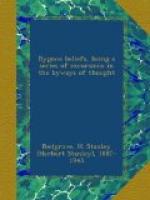Raphael Michael Sun Heart Lion Swan
Carbuncle
Gabriel Gabriel Moon Left foot Cat Owl
Crystal
Camael Zamael Mars Right hand Wolf Vulture
Diamond
Michael Raphael Mercury Left hand Ape Stork
Agate
Zadikel Sachiel Jupiter Head Hart Eagle
Sapphire
(=Lapis
lazuli)
Haniel Anael Venus Generative Goat Dove
Emerald
organs
Zaphhiel Cassiel Saturn Right foot Mole Hoopoe
Onyx
The names of the angels are from Mr Mather’s translation of Clavicula Salomonis; the other correspondences are from the second book of Agrippa’s Occult Philosophy, chap. x.
In many cases these supposed correspondences are based, as will be obvious to the reader, upon purely trivial resemblances, and, in any case, whatever may be said—and I think a great deal may be said—in favour of the theory of symbology, there is little that may be adduced to support the old occultists’ application of it.
So essential a part does the use of symbols play in all magical operations that we may, I think, modify the definition of “magic” adopted at the outset, and define “magic” as “an attempt to employ the powers of the spiritual world for the production of marvellous results, BY THE AID OF SYMBOLS.” It has, on the other hand, been questioned whether the appeal to the spirit-world is an essential element in magic. But a close examination of magical practices always reveals at the root a belief in spiritual powers as the operating causes. The belief in talismans at first sight seems to have little to do with that in a supernatural realm; but, as we have seen, the talisman was always a silent invocation of the powers of some spiritual being with which it was symbolically connected, and whose sign was engraved thereon. And, as Dr T. WITTON DAVIES well remarks with regard to “sympathetic magic”: “Even this could not, at the start, be anything other than a symbolic prayer to the spirit or spirits having authority in these matters. In so far as no spirit is thought of, it is a mere survival, and not magic at all...."[1]
[1] Dr T. WITTON DAVIES: Magic, Divination, and Demonology among the Hebrews and their Neighbours (1898), p. 17.
What I regard as the two essentials of magical practices, namely, the use of symbols and the appeal to the supernatural realm, are most obvious in what is called “ceremonial magic”. Mediaeval ceremonial magic was subdivided into three chief branches—White Magic, Black Magic, and Necromancy. White magic was concerned with the evocations of angels, spiritual beings supposed to be essentially superior to mankind, concerning which I shall give some further details later—and the spirits of the elements,—which were, as I have mentioned in “Some Characteristics of Mediaeval Thought,” personifications of the




